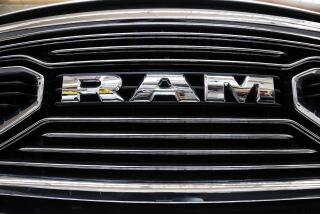Clean, diesel in one breath
- Share via
A drive up the Long Beach Freeway, trapped between a dozen soot-belching big rigs from the port, is a good example of why diesel engines have such a lousy reputation in this country.
Motorists know diesel not only from the tremendous air quality problems caused by big trucks and ships that ply waters off the coast, but from the clanking engines of the 1970s-era Mercedes-Benz cars and the kerosene-like odors that announce their arrival. But a revolution is underway and a key development occurred just last week that will have a major effect on the future of diesel.
Under new federal regulations, all of the nation’s gas stations began selling ultra-low-sulfur diesel, which contains 15 parts per million sulfur, down from an allowable 125 ppm in California and 500 ppm in the rest of the nation. The cleaner fuel will immediately reduce the formation of hydrocarbon and nitrogen oxide emissions by 30%. Proponents compare the introduction of lower sulfur diesel with the removal of lead from gasoline a generation ago.
The biggest potential benefit, however, lies in the development of future engines that can take full advantage of the lower sulfur.
Diesels already produce fewer greenhouse gases than gasoline engines, owing to their 30% to 40% energy efficiency advantage over gasoline. But they emit so much pollution and soot that they fail to meet air quality regulations for light-duty vehicles -- cars.
In 2005, U.S. consumers chose diesel engines for just 3.6% of all vehicles, excluding heavy trucks. By comparison, diesels made up 49.8% of vehicles sold in Europe, said Allen Schaefer, executive director of the Diesel Technology Forum, a Washington, D.C., advocacy group.
“This country has a gasoline-oriented economy,” Schaefer said. “The investments in refining, technology and vehicles have focused on gasoline.”
The potential of diesel was “held hostage” by low gasoline prices, Schaefer said. Although gasoline prices are again dipping, they are unlikely to drop to the very low levels seen earlier this decade. The growing demand for oil by India and China will put a continuing strain on supplies.
In the face of higher gas prices, the public hoopla over green cars and fuel efficiency has focused on hybrid cars and flexible fuel vehicles that burn ethanol. Consumers have discovered, however, that hybrid vehicles can fail to deliver on their highly touted claims of efficiency, and as a result may not be good economic choices. Ethanol, though it theoretically can reduce U.S. dependence on foreign oil, is more expensive to use than gasoline.
Over the next four years, the public will see whether diesel engines can deliver on hopes for improved emissions, better fuel economy and lower overall operating costs for consumers.
A lot of investment is riding on this bet. The refining industry has invested $8 billion on new technology and equipment to produce the new diesel fuels, said Tucker Hall, a spokesman at the Western States Petroleum Assn.
Clearly, car manufacturers have a long way to go in persuading consumers to try diesels. Many still remember the late 1970s fiasco, when General Motors tried to convert a gasoline engine to burn diesel. The defective engines were installed in Oldsmobiles, a brand that eventually died a few years ago.
But diesel is getting noticed. Between 2000 and 2005, diesel sales jumped 80%, though they still amounted to just 543,000 vehicles in 2005. That’s still more sales than hybrid engine-based vehicles and more than ethanol-capable vehicles.
GM, despite the fiasco with the Oldsmobile, has an aggressive diesel strategy. It recently introduced a new V-8 diesel for its heavy pickup trucks and plans to introduce a new one for light trucks in 2009, one that meets stringent new federal emission standards.
“Diesel is a very efficient technology,” said Robert Babik, director of vehicle emission issues at GM. “That’s why we are looking at it so closely.”
Clean diesels will qualify for the federal tax credits that apply to ethanol and hybrids. Until the new ultra low sulfur diesel became available, car manufacturers were not offering vehicles that would qualify for the credit, said Schaefer.
The stage seems set for some significant technology improvements, which could lead to diesels being cleaner than gasoline engines by 2010.
One plan is for diesels to treat oxides of nitrogen with urea, a type of ammonia, breaking them down to less harmful nitrogen and water compounds. Advanced filters would trap and remove soot, sending it back to the engine for a secondary combustion. The cars would emit up to 40% less carbon dioxide than gasoline engines, thanks to the engine’s efficiency.
Consumers can get a diesel engine for the rest of this year in the 2006 Volkswagen Jetta or a Mercedes-Benz E320, but that’s just about it. Chrysler plans to introduce a diesel for its Grand Cherokee, and the engines are also available in many medium-duty pickup trucks, such as the Silverado.
The Jetta, the only moderately priced diesel car offered in the U.S., is not sold in California, because it fails to meet the state’s tougher air quality standards. But Volkswagen hopes to introduce a new four-cylinder diesel with 140 horsepower that would comply with tougher U.S. and California rules.
Volkswagen, of course, produced one of the few successful automobile diesels decades ago in the Rabbit. The engines are still around and have a loyal base of owners. Indeed, many of the old Rabbits have been converted to burn discarded deep fryer grease from restaurants. The trend is documented at www.greasecar.com.
If diesel engines can attract a cult following, then the rest of the public may not be far behind, particularly if diesels can deliver on lower overall operating costs.
“As far as these people are concerned, they are really sticking it to the man,” said Keith Price, a Volkswagen spokesman in Auburn Hills, Mich.
More to Read
Inside the business of entertainment
The Wide Shot brings you news, analysis and insights on everything from streaming wars to production — and what it all means for the future.
You may occasionally receive promotional content from the Los Angeles Times.











